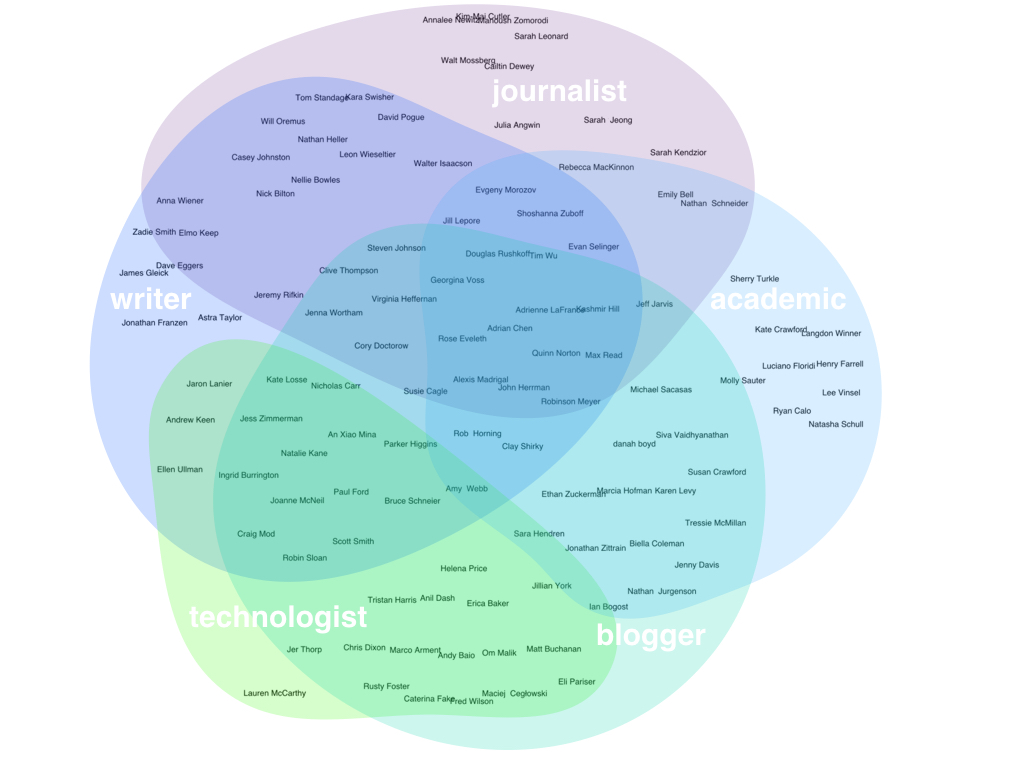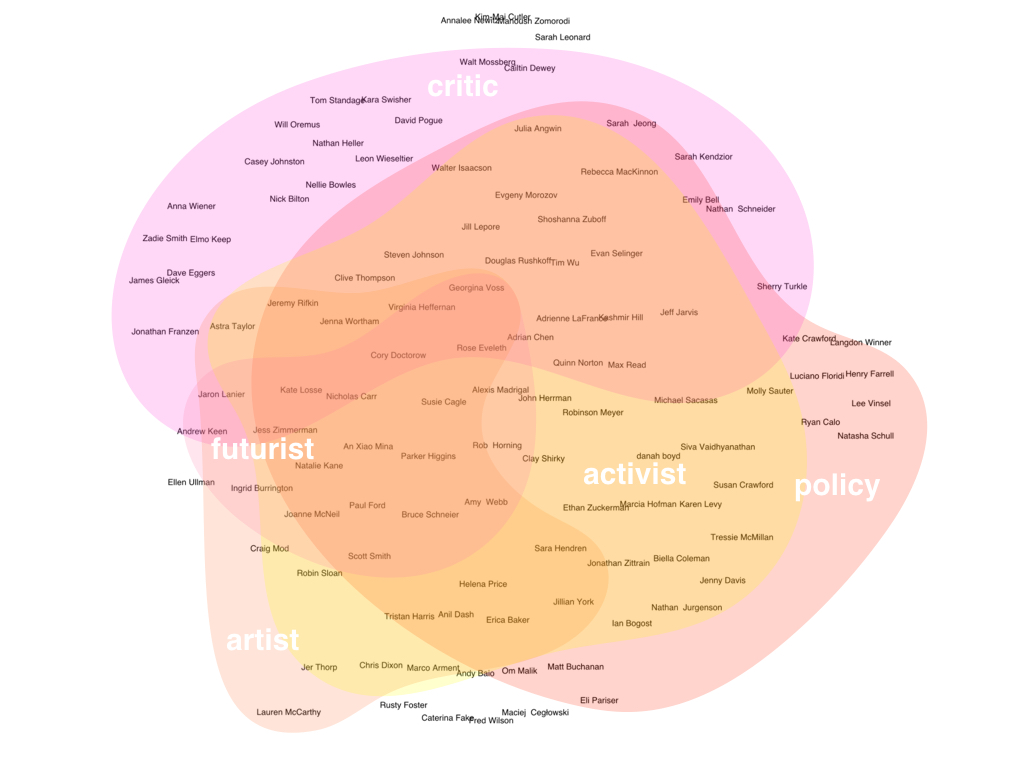Contributors to the Critical Discourse
My close reading of the body of technology writing and criticism reveals that a larger collection of writers, often professors and academic experts, are contributing to popular discourse through policy positions and op-eds. These voices commenting on technology come from a wide range of places and professional backgrounds. The media might recognize them as pundits, commentators, or public intellectuals. I offer a taxonomy of these voices below to better integrate and recognize their contributions to the critical public discourse about technology.
To build a more robust rubric of contributions to the critical discourse about technology, I started with writers acknowledged in the popular press as critics. I then looked to other writers who have offered meta-analyses of the role of tech criticism, such as in Henry Farrell’s “The Tech Intellectuals”116 and Evgeny Morozov’s “The Taming of Tech Criticism.”117 All the people I identified write in public (that is, not limited academic journals behind paywalls), either in popularly accessible publications or in blogs, Medium posts, or public talks. I considered an individual’s own chosen signifiers, and identified occupations in their public bios or bylines. I also relied on interview material and took my own estimations and analysis into account. I recognize the possibility of oversight and have admittedly skewed this list toward English-speaking and American sources based on my own limits of language and scope. It is by no means exhaustive and only reflects a snapshot of contributors at the time of publishing.
Having done this analysis, I find that the critical voices tend to fall into a few cohorts, with some overlaps reflected in the visual diagram. The network was created in Gephi using the ForceAtlas2 layout spatialization, where each name reflects a node, and their proximity is based on shared categorizations and roles. For example, academics who also focus on policy work are arranged closer together. Overlaying the network graph are Venn diagram shapes meant to highlight overlapping categorizations.
The first diagram image shows the primary categorization of the way contributors are writing, either as journalists, bloggers, writers, technologists, or academics.

Contributors to the Critical Discourse About Technology, Venn Diagram of Primary Roles and Titles
The second illustrates more focused specialities in their roles as activists, policymakers, critics, futurists, or artists. Secondary categorizations are less closely concentrated, so the Venn diagram areas capture more than just those who associate with that form of work. These graphs give a sense of the diversity of identities and roles contributors take on in the critical discourse of technology.

Contributors to the Critical Discourse About Technology, Venn Diagram of Specialties
The “Critics”
Evgeny Morozov, Nicholas Carr, Sherry Turkle, Andrew Keen, Douglas Rushkoff, and Jaron Lanier
These people make their living writing as self-proclaimed Critics, publishing books about their critical angles on current trends in technology with a decidedly negative, anti-technology stance. Morozov defines the target: “To be a technology critic in America now is to oppose that bastion of vulgar disruption, Silicon Valley.”118 Morozov counts himself among this specific cohort, including Nicholas Carr, Andrew Keen, Sherry Turkle, and Jaron Lanier, while dissecting the failures of this group’s particular brand of technology criticism.
Cross-Over Academics
Zeynep Tufekci, Jonathan Zittrain, Evan Selinger, Susan Crawford, Ethan Zuckerman, Tim Wu, Henry Farrell, Kate Crawford, Rebecca MacKinnon, Tressie McMillan, Deb Chachra, Shoshana Zuboff, Biella Coleman, Siva Vaidhyanathan, and danah boyd
Cross-over academics include those who publish beyond their audience of peer-reviewed journals and academic conferences. They blog, tweet, write on Medium, and contribute opinion pieces and popular book reviews, testing ideas in publications with broader reach. They are bridge figures, working to make their writing accessible to general audiences and stakeholders—from consumers, to technologists, to policymakers. These are academics who drop in to write commentary and opinion pieces and who attach their relevant work to the latest news hook. Sociologist and legal scholar Karen Levy describes her approach to this kind of writing: “Each style of writing improves the other—the public-facing stuff has a quicker turnaround and helps me think through emerging ideas in a ‘live’ way, while the academic stuff is backed with more thorough empirical research.”
Writing for the public may not add much to their tenure portfolios, but these writers are motivated to have a direct policy impact in the near future. Immersed in the new forms of publishing the internet allows, these academics do not judge their impact solely on the traditional metrics of academic publishing. In her response to Farrell’s dissection of the “The Tech Intellectuals,” free expression activist and Electronic Frontier Foundation director Jillian C. York writes about the clear motivations for straddling sides: “The modern ‘technology intellectual’ is often a public intellectual in true form, eschewing the slow pace of academia for the urgency of online debate.”119 Publications are eager for these cogent, timely, and informed angles, often with some policy angle or more precise articulation of the problem. Many of these academics also grew up as bloggers.
Journalists, Bloggers, Writers
Alexis Madrigal, John Herrman, Paul Ford, Adrian Chen, Rose Eveleth, Elmo Keep, Adrienne LaFrance, Joanne McNeil, Kate Losse, Clive Thompson, Virginia Heffernan, Max Read, Caitlin Dewey, Nathan Heller, Jill Lepore, Astra Taylor, Quinn Norton, Sarah Kendzior, Julia Angwin, Kashmir Hill, Annalee Newitz, Jess Zimmerman, and Sarah Jeong
This category includes writers who don’t consider themselves Critics but whose work takes on a decidedly critical angle. A select few in this crowd get the time and space to tackle questions about technology and society for publications like The New Yorker and The New York Times. Many of these journalists act as a bridge, translating academic material into contemporary contexts and issues. Nathan Heller explains, “I try to apply a critical intelligence even if I’m writing a reported piece, or something else that wouldn’t explicitly be called criticism.” Writers here often deploy these critical lenses, and write and report from specific perspectives.
Tech Insiders
Anil Dash, Marco Arment, Om Malik, Chris Dixon, Ellen Ullman, Caterina Fake, Fred Wilson, Bruce Schneier, Andy Baio, Tristan Harris, and Maciej Cegłowski. Rusty Foster and Paul Ford overlap between the technologists and writers.
These voices critique the technology industry from the inside, often in blog posts, op-eds, and speaking engagements. They are entrepreneurs, developers, engineers, and venture capitalists with something to say. Their primary audience is often their peers in the industry, but their material sometimes reaches beyond techies.